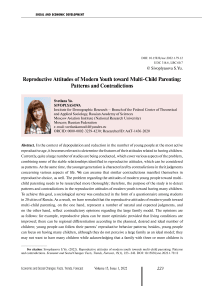Reproductive attitudes of modern youth toward multi-child parenting: patterns and contradictions
Автор: Sivoplyasova Svetlana Yu.
Журнал: Economic and Social Changes: Facts, Trends, Forecast @volnc-esc-en
Рубрика: Social and economic development
Статья в выпуске: 1 т.15, 2022 года.
Бесплатный доступ
In the context of depopulation and reduction in the number of young people at the most active reproductive age, it becomes relevant to determine the features of their attitudes related to having children. Currently, quite a large number of studies are being conducted, which cover various aspects of the problem, combining some of the stable relationships identified in reproductive attitudes, which can be considered as patterns. At the same time, the younger generation is characterized by contradictions in their judgments concerning various aspects of life. We can assume that similar contradictions manifest themselves in reproductive choice, as well. The problem regarding the attitudes of modern young people toward multichild parenting needs to be researched more thoroughly; therefore, the purpose of the study is to detect patterns and contradictions in the reproductive attitudes of modern youth toward having many children. To achieve this goal, a sociological survey was conducted in the form of a questionnaire among students in 20 cities of Russia. As a result, we have revealed that the reproductive attitudes of modern youth toward multi-child parenting, on the one hand, represent a number of natural and expected judgments, and on the other hand, reflect contradictory opinions regarding the large family model. The opinions are as follows: for example, reproductive plans can be more optimistic provided that living conditions are improved; there can be regional differentiation according to the planned, desired and ideal number of children; young people can follow their parents’ reproductive behavior patterns; besides, young people can focus on having many children, although they do not perceive a large family as an ideal model; they may not want to have many children while acknowledging that a family with three or more children is the most optimal one; it may also happen that young people want to have many children, but at the same time show an increasingly negative attitude toward other multi-child families. Thus, these contradictions can be considered as a kind of barrier that can restrain the implementation of young people’s reproductive plans; therefore, they should be leveled within the framework of socio-demographic policy.
Multi-child parenting, reproductive attitudes, attitude toward having many children, depth of multi-child parenting, parental family, youth, survey, regions of Russia
Короткий адрес: https://sciup.org/147237313
IDR: 147237313 | УДК: 314.6
Текст научной статьи Reproductive attitudes of modern youth toward multi-child parenting: patterns and contradictions
In Russia’s contemporary history, the issues of demographic development are particularly acute. The demographic situation remains complicated. After a short period of natural growth in 2013–2015, natural population decline continued, amounting to 702 thousand people in 2020, which corresponds to the indicators of the 1990s – the first half of the 2000s. It is obvious that the COVID-19 pandemic has made a certain contribution to the indicators of the natural population movement in the previous two years strengthening depopulation processes. Given its “protracted” nature, we can assume that the effects will manifest themselves in the long term. The more urgent are the issues of increasing the birth rate and increasing the number of children of families in the country.
The objective factor influencing the fertility dynamics is the number of population at reproductive age, primarily women. Recently, there has been a tendency to reduce the number of women in active reproductive age. Even if we take into account the fact of an increase in the mothers’ average age at birth and consider the period 20–34 years as the active reproductive age, the number of women in this group decreased by 3.8 million people over the eleven years from 2011 to 2021 and amounted to 13.7 million people in 2021. Such dynamics significantly complicate the achievement of the key goal of the country’s demographic policy – transition to natural growth and population increase, since an increasing number of children are needed to cover the growing mortality. Consequently, the issue of increasing the number of multi-child families in the country and children’s birth of high priority is particularly significant.
In such a situation, it is important to determine reproductive attitudes of numerically shrinking youth’s cohort. This task can be solved by conducting a sociological survey. The results will help in identifying possible vectors of demographic development in Russia, as well as in improving the measures of demographic and family policy of the state.
Research in the field of reproductive intentions is conducted regularly. For the first time, this issue was raised in the 1930s in the United States, when the American Institute of Public Opinion published the results of a survey on the ideal number of children in American families (Newport, Wilke, 2013).
Currently, the Federal State Statistics Service of Russia provides analytical reports on the survey results, the purpose of which is to identify the reproductive plans of population1. The research results show how many children respondents expect and would like to have under all necessary conditions. The emphasis in the publications is on identifying gender differences in reproductive plans, as well as the relationship of the social status and economic well-being with the desired and expected number of children.
Analytical sociological centers conduct similar studies. For example, the All-Russian Public Opinion Research Center (VCIOM) in 2020 presented a report “Demographic policy of the Russian Federation: Factors stimulating decisionmaking on the birth of the first and second child, as well as subsequent children” (Rodin, 2020). During the survey, indicators of the desired and expected number of children were determined; motivational incentives and barriers to birth, mainly first and second children, were identified.
In 2019, Yuri Levada Analytical Center “Levada-Center”* conducted a research “The desired and expected number of children”2. The presented results reflected the average desired and expected number of children by gender.
In scientific discourse, the problem of determining the desired, expected and ideal number of children is also very popular. Among Russian scientists, V.A. Belova and E.V. Darsky became pioneers in this field; they made a significant contribution to the methodology of research on reproductive, and in the 1970s conducted large-scale studies in the republics of the USSR and revealed the dependence of intentions regarding the number of children in families on the respondents’ nationality, family income level and parents’ education3 (Belova, Darsky, 1972; Belova, 1975).
Currently, interest in this topic remains at a high level. Surveys are conducted among different population groups, most often people of reproductive age in general or youth whose representatives are just about to become parents. At the same time, the analysis of publications on the topic showed that in most cases the research concerns several relevant areas. First, scientists seek to discover the relationship between reproductive attitudes and the level of education of respondents. For instance, in the course of a study of the female reproductive behavior with different educational status, V.N. Arkhangelsky, S.G. Shulgin and Yu.V. Zinkina have identified an inverse relationship between education level and the desired and planned number of children (Arkhangelsky et al., 2020).
Second, often the work is aimed at identifying the relationship between reproductive attitudes and families’ material well-being level. For example, the study of E.V. Churilova and S.V. Zakharov to a certain extent has confirmed the preservation of the inverse relationship between the financial situation and the expected number of children in the family (Churilova, Zakharov, 2019). V.N. Arkhangelsky, T.K. Rostovskaya and E.V. Vasilyeva elaborated on this thesis, revealing the presence of feedback between the desired/expected number of children and women’s income level, while male responses demonstrated a direct relationship between these parameters (Arkhangelsky et al., 2021).
Third, the researchers focus on the impact of implementation of state demographic policy measures on Russians’ reproductive choice. In particular, L.A. Popova and M.A. Shishkina note: if the activation of pro-family policy measures in Russia since 2005 has had a stimulating effect on the reproductive choice of representatives of the generation born in 1989–1993, who are the main “recipients” of these measures, then the cohort representatives born in 1999–2000 do not perceive the currently implemented programs as stimulating. The authors conclude that in order to improve the demographic situation in the country, it is necessary to expand the list of measures of state support for families with children (Popova, Shishkina, 2016).
Fourth, studies are often conducted in a regional context, regional peculiarities of respondents’ reproductive attitudes are revealed. For example, E.M. Dumnova analyzed the factors influencing the reproductive attitudes of Novosibirsk students (Dumnova, 2009). A.G. Yaschuk, A.V. Maslennikov, I.R. Rakhmatullina and N.A. Ishmuratov have conducted a research of Ufa youth’s reproductive behavior. As a result, the authors have revealed low readiness for parenthood and postponement of childbearing to a later date (Yaschuk et al., 2019). E.V. Volchenkova compared the reproductive attitudes of young people in Kirov, Nizhny Novgorod and Samara, and found out that the implementation of even the most optimistic reproductive plans of residents will not allow reaching the level of simple reproduction. Moreover, the situation in Kirov is the most alarming (Volchenkova, 2014). K.N. Obukhov identified that young people consider a two-child family to be the most preferred family model in the Udmurt Republic (Obukhov, 2021). O.N. Kalachikova compared reproductive attitudes of the Vologda Oblast students living in urban and rural areas. In the course of the study, the researcher confirmed the hypothesis about the orientation toward the birth of a larger number of children among young people living in rural areas, compared with urban youth (Kalachikova, 2012).
Fifth, the problem of voluntary childlessness, or “childfree” model, occupies a special place in the scientific discourse. For instance, D.V. Belinskaya tried to make a social portrait of a voluntarily childless woman. The research results showed that a typical “childfree” is a young woman with higher education, above average income, living in a big city (Belinskaya, 2018). E.I. Garayeva focused on the causes and motives of voluntary childlessness. In the author’s opinion, this phenomenon is determined by liberalization of higher education, female emancipation and gender equality. In addition, the conducted research shows that modern young people associate the lack of desire to have children with financial difficulties, uncertainty about the future and themselves (Garayeva, 2018; Garayeva, 2020).
The topic of reproductive attitudes and dynamics of the desired, expected and ideal number of children is popular among foreign scientists. At the same time, there are regional differences in the research directions. For example, while studies of reproductive attitudes and characteristics of women’s reproductive behavior living in developed countries, such as European countries, the USA, Australia and others, are focused on identifying the causes of low fertility and refusal to have children4 (Johnstone et al., 2021), studies of fertility and patterns of reproductive choice among women living in African states, in particular in subSaharan countries, record that high fertility rates persist at the present time. Scientists identify factors contributing to a later onset of childbearing and a decrease in the total number of children born to one woman (Atake, Gnakou, 2019; Baschieri et al., 2013; Gunter, Harttgen, 2016; Molla, Muluneh, 2019; Yaya, Osanyintupin, 2018). Scientists are concerned about the decline in the birth rate in Arab countries, for example in Iran. There is a decrease in the need for children. In this regard, we propose to conduct conversations with future spouses and find out their reproductive plans (Lotfi et al., 2017).
Studying the childfree phenomenon in Western countries has remained relevant for several decades. At the same time, scientists note the formation of a more tolerant attitude in society toward people who choose childless lifestyle (Koropeckyj-Cox et al., 2018). In addition, nowadays, new justifications for voluntary childlessness are emerging in the
4 Doepke M., Kindermann F. (2016). Why European women are saying no to having (more) babies. VOXeu CEPR.
context of globalization. E. Nakkerud speaks about the relationship of such a model of reproductive behavior with the respondents’ desire to preserve a clean environment (Nakkerud, 2021).
Thus, the analysis of publications has shown that there is a fairly wide range of research areas of reproductive attitudes. Nevertheless, many of them are united by the approach, used to group respondents according to the desired and planned number of children. In the vast majority of cases, scientists identify groups of people, focused on the birth of one, two, three or more children. A group of respondents who want or plan to have four or more children is rarely considered separately. It means that the issue of population orientation to children’s birth of high priority remains poorly studied.
The conclusions of various researchers reveal the existence of a number of stable relationships concerning the reproductive intentions, which can be considered as patterns. These are, for example, more optimistic reproductive plans of respondents in the presence of all the conditions necessary for children’s birth, compared to the planned number of children, orientation to the birth of more children among respondents in rural areas, compared to urban residents, etc. Based on the above, within the framework of our research, we have put forward a hypothesis about the existence of certain stable patterns in the attitudes of modern young people toward multi-child parenting.
At the same time, the works of scientists on the attitude of modern youth to various phenomena of public life (see, for example, Zubok, 2020; Zubok, Chuprov, 2020) show that judgments abound with peculiar contradictions; it means that youth’ s opinion often depends on the surrounding conditions (context), actors and other reasons and can combine multidirectional judgments. In this regard, we can assume that there are also some contradictions in the reproductive attitudes of young people to having many children. Their identification within the framework of our study is of particular interest, since this antinomy can be considered as a certain “barrier” for the formation and implementation of more positive reproductive intentions of the cohort, which in the very near future will create families and become parents. It is likely that the resolution of contradictions will contribute to an increase in the need for a large number of children among young people, a more complete implementation of reproductive plans, and consequently, an improvement in the demographic situation in the country.
Thus, we have set a goal on the basis of a sociological survey of modern Russian student youth to identify patterns and contradictions in reproductive attitudes to having many children.
Research methodology
The research is based on the analysis of the results of a sociological survey of students studying at Russian universities. Employees of the Department of Fertility and Reproductive Behavior of the Institute for Demographic Research of the Federal Center of Theoretical and Applied Sociology of the Russian Academy of Sciences S.Yu. Sivoplyasova and E.P. Sigareva5 have conducted a survey in the form of a questionnaire. One of the goals of the survey was to identify the youth’s reproductive intentions and their attitude to having many children.
The choice of the respondents’ category is nonaccidental and is due to several reasons. First, modern students are people who will soon create their own families and implement their reproductive plans. Second, young people receiving higher education live in a specific environment, under the influence of which they form special requirements for living standards, influencing, among other things, life strategies and reproductive attitudes; therefore, in the near future, Russia’s demographic development depends on their matrimonial and reproductive behavior.
The survey was conducted in twenty cities of Russia (Moscow, Serpukhov, Khanty-Mansiysk, Stavropol, Budennovsk, Ulan-Ude, Vologda, Yoshkar-Ola, Murom, Sevastopol, Belgorod, Karachaevsk, Makhachkala, Kizlyar, Vladivostok, Ufa, Maykop, Kursk, Kaliningrad, and Pskov). Territories (cities) were selected, which made it possible to identify the specifics of youth’s ideas and compare their reproductive intentions in the metropolis and province, in various regions of the country, located in all federal districts (within the borders of federal districts until November 3, 2018), as well as in entities of different types of administrative-territorial entities.
Respondents filled out paper questionnaires containing 24 questions, divided into logical blocks. The first block included the questions of the address part concerning the structure of the respondents’ sample. The second block was devoted to the evaluation of demographic policy measures and socio-psychological components of attitudes toward different family types. The third block consisted of questions, related to youth’s ideas about the signs of belonging to the middle class as the basis for socio-economic and demographic well-being. A total of 2,135 questionnaires were processed. Among the respondents, 61.5% are girls, 38.5% are boys. The largest share of respondents was formed by young people aged 19–20 (35%), 28% were students aged 16–18, 21% – aged 21–25, 9% – under 16 years old. The rest of the respondents are aged 26–30. The sample was disproportionate and was based on a simple random, non-repetitive selection. Representativeness was within the limits of statistical error (Sivoplyasova, Sigareva, 2021).
In the course of the research, students were asked a number of questions, the answers to which allow judging the planned, desired and ideal number of children (Sigareva, Sivoplyasova, 2021): “How many children are you going to have?”, “How many children would you like to have if all the necessary conditions were available for this?”, “How many children is it best to have nowadays in Russia?”. The questions were open, which made it possible to analyze the depth of the large number of children that the respondents were focused on. Sometimes there were interval responses. When processing the results, the largest number from the interval was taken into account. However, given that there was a small number of such questionnaires, it is safe to say that the conclusions drawn from the research results are reliable.
One of the purposes of the survey was to determine the depth of transformation of the youth’s attitude to the families of their friends, relatives, acquaintances in the event of the birth of another child. The question was formulated as follows: “Will your attitude toward the families of your acquaintances, friends, and neighbors change after the birth of another child in them?” There were three possible respond options: “it will change for the better”, “it will change for the worse”, and “it will not change in any way”. The answer had to be given for each next child. This approach made it possible to trace the change in attitude in dynamics.
In addition to the survey results, statistical data of the All-Union Population Census of 1989, the All-Russian Population Census of 2002 and the AllRussian Population Census of 2010, as well as the survey results of multi-child families (mothers) “Lifestyle of multi-child families in Russia”, conducted by the Department of Family Sociology and Demography of the Faculty of Sociology of Moscow State University (the head is A.I. Antonov) in 2007–2008 were analyzed.
Research results and discussion
Before talking about reproductive attitudes of modern students to having many children, it is important to determine which family will belong to this category. It seems paradoxical that the concept of “multi-child family” has not yet been defined in Russian legislation at the federal level. The only regulatory legal act of the federal level concerning exclusively multi-child families remains the Presidential Decree of the Russian Federation no. 431 “On measures for social support of multi-child families”, dated May 5, 19926. However, even it does not contain an unambiguous interpretation of this concept. The republics’ governments within the Russian Federation, the executive authorities of krais, oblasts, autonomous entities, cities of federal significance are invited to independently determine family categories that belong to multi-child families and need additional social support taking into account national and cultural characteristics, territory’s socio-economic and demographic development. Thus, today each region chooses which families to classify as having many children, based on the real scale of this phenomenon, as well as its budgetary capabilities, since the recognition of a multi-child family entails a certain set of social support measures.
In the overwhelming majority of Russia’s entities, families with three or more children under the age of 18 are considered multi-child families. We will use this interpretation in the framework of the article.
It is possible to estimate the number of multichild families in Russia using statistical data from the All-Russian Population Censuses. For instance, according to the 2010 census, the share of households with three or more children in the total number of households was 3.1% ( Tab. 1). Compared with 2002, their share increased by 0.5 p.p., but still have not reached 1989 level.
If we consider households’ child structure analyzing households with children, the share of multi-child families will be 7%, with two children – 27.2%, with one child – 65.5% (Fig. 1) . Compared with 2002, in 2010, the share of households with three or more children increased by 0.4 p.p., but compared with 1989, it is 2.5 p.p. lower.
The households’ structure by the number of children is heterogeneous in the regional context (Tab. 2) . According to the Russian Population Census of 2010, the largest share of households with three or more children was observed in the North Caucasian Federal District (14.6%), the smallest one was in the North-West (1.7%). It is interesting to note that the share of households with one child and two children does not have such a significant differentiation. In the first case, it ranges from 24.8% in the North Caucasian Federal District to 31.0% in the Far East, in the second – from 9.9% in the Central Federal District to 19.4% in the North Caucasus.
Table 1. Structure of Russian households by the number of children in 1989, 2002 and 2010, %
Household type 1989 2002 2010 Childless households 53.4 59.9 55.9 Households with 1 child 23.7 28.2 28.9 Households with 2 children 18.3 11.3 12.1 Households with 3 and more children 4.6 2.6 3.1 According to: USSR population (1990): according to the All-Union Population Census of 1989. USSR State Committee on Statistics. Information and Publishing Department. Moscow: Finansy i statistika, 45 p.; Information and Publishing Department Russian Population Census of 2002, Russian Population Census of 2010. Federal State Statistics Service. Available at:
6 On measures for social support of multi-child families: Presidential Decree of the Russian Federation no. 431, dated May 05, 1992. Legal Reference System Consultant Plus. Available at: d=D1E4C0F7C7E2BB01E7DD241EDF2C38E5&SORTTYPE=0&BASENODE=1-1&ts=YO88dnSMk5zihbvF1&base=LA W&n=41141&rnd=CCF372F29B0CD448E3CDF4C01531DAFC#IEL8dnS996CWdImT
Figure 1. Distribution of households by number of children under aged 18 in 2010, %
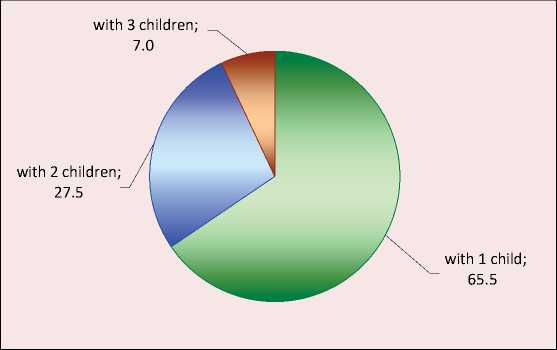
According to: All-Russian Population Census of 2010. Federal State Statistics Service. Available at: vpn_popul
Table 2. Share of households with children in the total number of households in 2010 by federal districts, %
Household type Federal district With 1 child With 2 children With 3 and more children Central Federal District 28.2 9.9 1.8 Northwestern Federal District 30.0 10.1 1.7 Southern Federal District 28.2 13.0 3.0 North Caucasian Federal District 24.8 19.4 14.6 Volga Federal District 29.4 12.5 2.5 Ural Federal District 28.6 14.7 2.9 Northern Federal District 29.9 13.1 3.3 Far-Eastern Federal District 31.0 12.7 3.1 According to: Russian Population Census of 2010. Federal State Statistics Service. Available at:
Multi-child families’ level varies significantly across the country’s regions. According to the 2010 Census, the differentiation of the share of multichild families in the total number of families ranges from 29% in the Republic of Ingushetia to 0.9% in Saint Petersburg (Fig. 2) . However, the 2002 Census data indicate that at the millennium beginning, the differentiation was even greater – from 39% in the Republic of Ingushetia to 0.9% in Saint Petersburg.
The period after the previous population census in 2010 was the main stage of the implementation of demographic policy measures. The result was an increase in the birth rate in the country. The number of not only second, but also third births has increased. For instance, according to the estimates of the Ministry of Labor and Social Protection of the Russian Federation, by 2017, compared with 2010, the number of multi-child families in Russia increased by 25% and amounted to 1.556 million7. According to the children’s ombudsman A. Kuznetsova, by 2021 their number has become even greater. As of January 1, 2021, the number of multi-child families reached 1.96 million. Only
Figure 2. Share of multi-child families in the total number of family units in 2010 by Russia’s regions, %
0510 15 20 25 30 35
Republic of Ingushetia
Chechen Republic
Republic of Dagestan
Republic of Tyva
Kabardino-Balkarian Republic
Karachai-Cherkess Republic
Republic of North Ossetia – Alania
Republic of Altai
Republic of Sakha (Yakutia)
Republic of Kalmykia
Chukotka Autonomous Okrug
Nenets Autonomous Okrug
Republic of Buryatia
Republic of Adygea
Yamalo-Nenets Autonomous Okrug
Zabaykalsky Krai
Stavropol Krai 1I
Republic of Bashkortostan ]I
Astrakhan Oblast 11
Tyumen Oblast I1
Irkutsk Oblast pp
Republic of Khakassia ]1
Khanty-Mansi Autonomous Okrug J1
Jewish Autonomous Region J1
Amur OblastJ1
Krasnodar Krai p^
Udmurt Republicpp
Perm Krai pp
Kurgan Oblast pp Krasnoyarsk Krai p^
Chuvash Republic j=i Orenburg Oblast |=i
Omsl Oblast pp
Tomsk Oblast pp Mari El Republic ^^
Republic of Tatarstan pp Kemerovo Oblast j= i Volgograd Oblast =i
Chelyabinsk Oblast□ Novosibirsk Oblastpp
Magadan Oblast pp Arkhangelsk Oblast □
Rostov Oblast □
Sverdlovsk Oblast Q Altai Krai □
Kamchatka Krai □ Bryansk Oblast □
Lipetsk Oblast □ Komi Republic □
Vologda Oblast Q Khabarovsk Krai = Belgorod Oblast □
Kaluga Oblast □ Kostroma Oblast □
Kursk Oblast □
Oryol Oblast □ Tver Oblast □
Kaliningrad Oblast □ Novgorod Oblast □
Pskov Oblast □
Primorsky Krai □ Ryazan Oblast □
Tambov Oblast=
Moscow =
Republic of Karelia Q Saratov Oblast Q
Sakhalin Oblast □
Voronezh Oblast □
Kirov Oblast □
Vladimir Oblast □ Moscow Oblast □
Yaroslavl Oblast □ Leningrad Oblast □
Nizhny Novgorod Oblast □
Penza Oblast Q Samara Oblast □
Ulyanovsk Oblastpl Ivanovo Oblast p
Smolensk Oblast p
Tula Oblastp Murmansk Oblast p
Republic of Mordovia p Saint Petersburg ■
According to: Russian Population Census of 2010. Federal State Statistics Service. Available at: popul in the pandemic year alone, the growth was 6.1%. Currently, 6.5 million children are brought up in multi-child families8.
At the same time, as noted earlier, the gender and age structure of the country’s population has tended to change negatively in recent years, which is associated with a reduction in the number of female cohorts of active reproductive age; therefore, more births are required for stabilization and positive development of the demographic situation, and of a high priority.
The survey results to determine the characteristics of reproductive attitudes of modern young students, to identify patterns and contradictions inherent in them, showed that the majority of representatives of modern students plan to become two-child parents (49.5% of respondents; Fig. 3 ). 14.8% of respondents would like to have one child. A third of respondents (32.7%) plan to have many children. However, about 3.0% of students plan to remain childless.
Reproductive plans of modern youth differ significantly by region (Fig. 4) .
If respondents living in the North Caucasian republics traditionally plan to become parents with many children, then in other entities no more than a third of students would like to have three or more children.
The largest share of young people planning to have three or more children is noted in Karachayevsk, Makhachkala and Kizlyar, the smallest one is in Pskov (15.9%). At the same time, it is worth noting that in Ulan-Ude, Karachayevsk, Makhachkala, Kizlyar and Maykop, the share of the option “I plan to have three or more children” is leading. In other cities, the most common answer is “two children”.
No more than a fifth of respondents plan to remain single-child parents (the exception is Kursk, where 25.3% of respondents plan to become singlechild parents). However, in Serpukhov, Khanty-Mansiysk, Stavropol, Budennovsk, Ulan-Ude, Makhachkala, Vladivostok and Maykop no more than 10% of students chose this answer, and in Karachayevsk and Kizlyar there were no young people planning to have such a small number of

Source: hereafter, unless otherwise indicated, it is own compilations.
Figure 4. Distribution of respondents by planned number of children by region, %
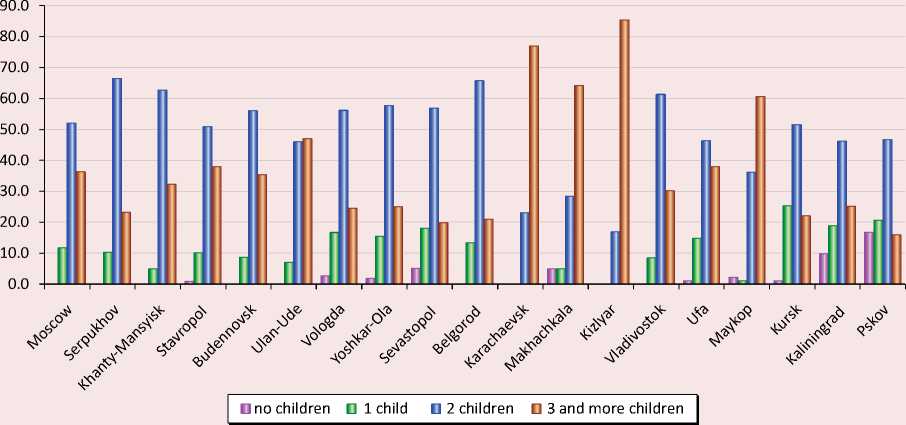
children, while in Vologda, Yoshkar-Ola, Ufa, Kursk, Kaliningrad and Pskov the proportion of such students exceeded 15%.
It is interesting to analyze the students’ answers to the question about the planned number of children in Pskov. This is the only city in which the share of respondents who do not plan to commit themselves to parenthood exceeds the share of young people who plan to become parents with many children (16.8% vs. 15.9 respondents, respectively).
Many factors influence people’s reproductive plans. As the conducted research has shown, most often they have an economic nature, so it is important to understand how much the birth rate can increase if all the conditions necessary for the birth of children are created for families.
Analysis of respondents’ answers to the question about the desired number of children in the presence of all necessary conditions proved that young people demonstrate more optimistic reproductive intentions (Fig. 5). The proportion of respondents wishing to become parents with many children is noticeably higher than the proportion planning to have three or more children.
Half of the respondents would like to have three or more children if they have all the necessary conditions. At the same time, in nine out of twenty cities (Moscow, Khanty-Mansiysk, Stavropol, Budennovsk, Ulan-Ude, Karachayevsk, Makhachkala, Kizlyar and Maykop), the proportion of respondents who chose this answer option exceeded 50%. The maximum is noted in Kizlyar (90.0% of respondents); the minimum is in Pskov (22.7%). It is important to note that in Pskov, even with all the necessary conditions, 11.3% of respondents would like to remain childless.
In addition to determining the planned and desired number of children, the researchers were faced with the task of identifying the “ideal”, according to respondents, the number of children in modern Russian families. The question was “How many children is it best to have in a family nowadays in Russia?”
Figure 5. Comparison of the proportions of respondents planning and wishing to become parents with many children, %
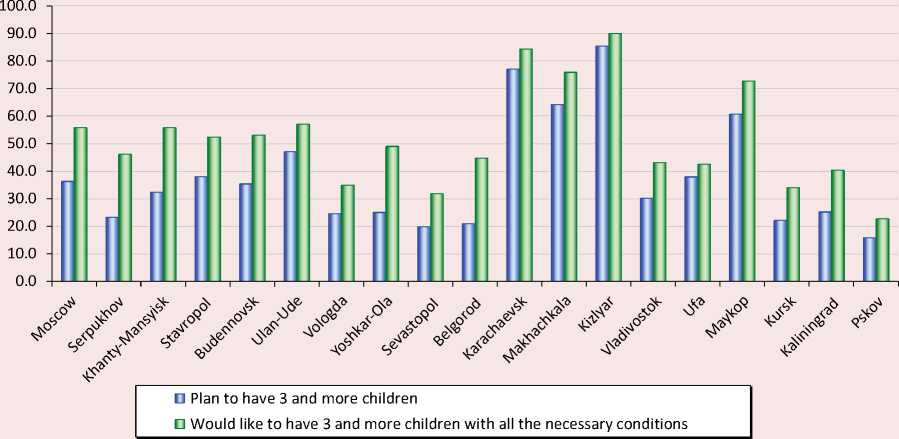
Figure 6. Distribution of respondents by the “ideal” number of children, %
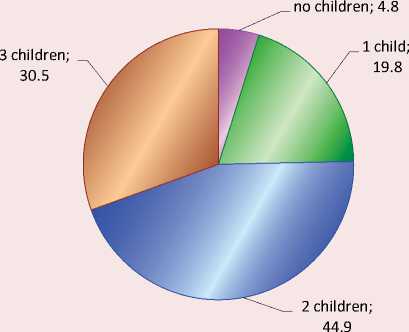
The majority of students believe that it is currently best to have two children in Russia (44.9%; Fig. 6). At the same time, 19.8% of respondents called a family with one child an ideal model, and a multi-child family is considered ideal by 30.5% of respondents. Thus, according to young people, modern conditions contribute to the formation of a family with few children (according to the classification of demographers) rather than a multi-child one.
There are regional differences in youth’s ideas about the ideal childhood model. Respondents in the North Caucasian republics demonstrate the most positive views. The proportion of students in Karachayevsk, Makhachkala, Kizlyar and Maykop who chose the option “three or more children” when answering the question about the ideal number of children exceeded the proportion of respondents who chose other answer options. Students in Kaliningrad and Pskov demonstrated the most pessimistic views regarding the ideal childhood model. The proportion of respondents who chose the option “zero children” in these cities was the highest, compared to the responses in other cities, amounting to 16.7 and 26.6%, respectively.
Thus, comparing the students’ answers about plans, desires and ideal viewpoints about having many children, we can note that there are no conditions for the full realization of youth’s reproductive intentions in any of the considered settlements (Fig. 7) . At the same time, in Moscow, Serpukhov, Khanty-Mansiysk, Vologda, Yoshkar-Ola, Sevastopol, Ufa, Kursk, Pskov, respondents strive to implement an ideal family model; according to their opinion, it is a multi-child family. The differences in the number of students planning the birth of three or more children and calling this number of children the best are insignificant.
At the same time, in Budennovsk, Ulan-Ude, Karachayevsk, Kizlyar, Vladivostok, Maykop, Kaliningrad, the difference between these two indicators is statistically significant. Moreover, the proportion of young people who plan to become parents with many children is higher than the proportion of students who see a multi-child family as an ideal model. It means that they deliberately “break stereotypes” and are ready to form an “unpopular” family model. However, the situation is different in Belgorod and Makhachkala. The proportion of respondents planning the birth of three or more children is significantly lower than those who consider a multi-child family to be the best model. Based on this, we can conclude that the youth of these cities are prone to some restraint in the implementation of reproductive plans and do not seek to give birth to more children, for which, in principle, conditions exist.
In order to determine what is the most likely, as well as the possible demographic future of Russia, we have compared the average planned and desired number of children. On average, in the cities considered, student youth plans to have 2.25
Figure 7. Comparison of the proportions of respondents who plan, want to have three or more children and represent a multi-child family as an ideal model, %
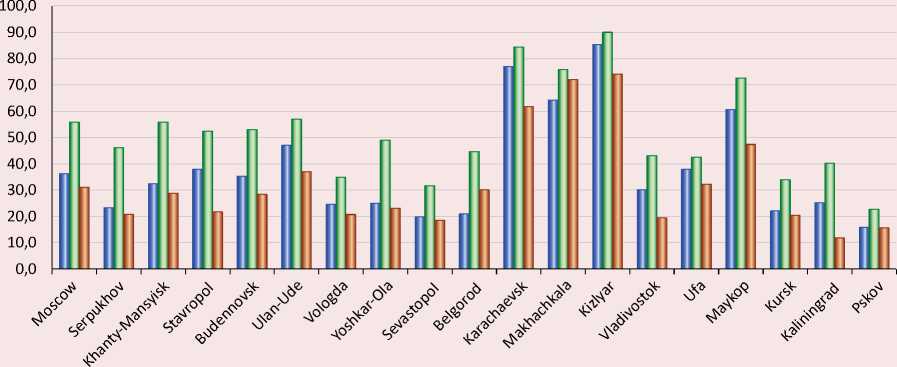
п Plan to have 3 and more children □ Would like to have 3 and more children □ Ideal number of children is 3 and more
children. At the same time, if all the necessary conditions are in place, this number will increase to 2.66 children. Such a birth rate will allow the country to reach the simple reproduction rate. Thus, the expansion of socio-demographic policy measures will help to fully implement the reproductive plans of modern young people, which will contribute to improving the demographic situation in Russia.
For the purposes of the study, it is not just to determine the proportion of young people who want to become parents with many children, but also to reveal the depth of the planned multi-child family (Fig. 8) .
The analysis of respondents’ answers showed that young people planning to become parents with many children most often want to have three children (72.2% of the number of people planning to become parents with many children). However, the indicator is highly differentiated by the country’s regions. So, in Serpukhov, among students planning to have many children, all respondents strive for the birth of three children, and in Maykop, the share of such young people is only 47.4%.
Plans for the birth of children of a higher priority are expressed by a noticeably smaller number of respondents, compared with those who plan to become parents of three children. In the North Caucasian republics, about a third of respondents want to have four children in their families, about 10% – five children. It means that the depth of planned multi-child families in the southern regions of the country is greater than in other regions.
As we have noted earlier, with improved conditions, youth’s reproductive plans will change for the better. This positive trend is also evident among students planning to have a multi-child family. It means that with the improvement of living conditions in the families of modern students, children of a higher priority may appear. At the same time, if in Moscow, Serpukhov, Budennovsk, Yoshkar-Ola, Sevastopol, Belgorod, Karachayevsk, Vladivostok, Kaliningrad and Pskov, the depth of multi-child families will increase due to the fourth births, then in Khanty-Mansiysk, Ulan-Ude, Vologda, Makhachkala, Kizlyar, Ufa and Maykop due to the fifth.
Figure 8. Distribution of respondents planning to have a different number of children, % of those planning to become parents with many children
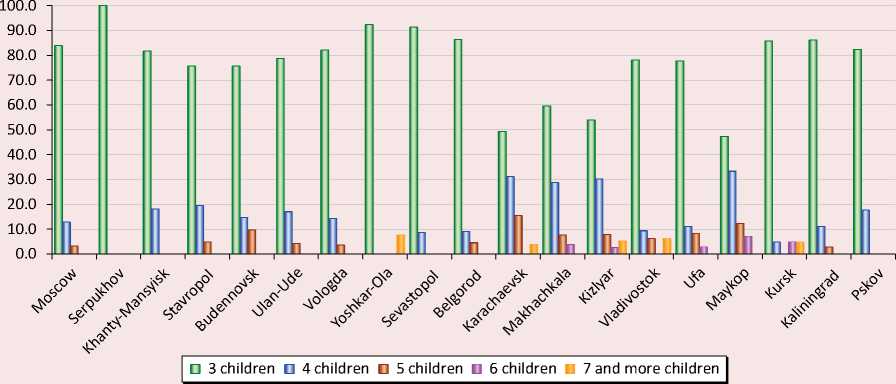
Previous studies have repeatedly proved that the child generation often repeats the model of reproductive behavior of their parents (Grishina, 2006; Karpova, 2019; Dobrokhleb, Zvereva, 2016; Sivoplyasova, Sigareva, 2018), therefore, one of the tasks of the analysis was to determine the similarities and differences between the childhood of the respondents’ parental family and their own reproductive plans.
According to the research results, the younger generation, who grew up in multi-child families, tends to “copy” the reproductive behavior of their parents (Fig. 9) .
However, the situation varies depending on the respondents’ region of residence. We have selected four cities for visualization, in which the reproductive plans, desires and ideas about the ideal family model of students corresponded to the orientation of a multi-child, medium-sized and small (and childless) family. Such cities included Makhachkala, Maykop, Moscow and Pskov (Tab. 3) .
The survey results show that in almost all analyzed cities (except Maykop), the proportion of the students, who plans to have three children, is greater than the proportion of parental families with three children. In this regard, there may be an “illusion” that the demographic situation is currently able to improve compared to the parental generation. However, it is worth noting that in these cities at the same time youth’s proportion who want to give birth to children of a higher priority is decreasing, which will negatively affect the dynamics of the country’ s demographic development.
A different situation is noted in Maykop. Plans for the birth of three children among the younger generation are declining compared to parental families amid a significant increase in the proportion of students who want to have four, five and six children. The differentiation ranges from 7 (in the case of six children) to 16.3 percentage points (in the case of four children).
Thus, in the settlements under consideration, young people “copy” parents’ reproductive behavior, but with some negative dynamics of childhood. At the same time, according to the survey results, significant regional differentiation in decision-making regarding the choice of the future number of children will remain.
Figure 9. Number of children in the parental family and planned number of children, % of the number of multi-child families
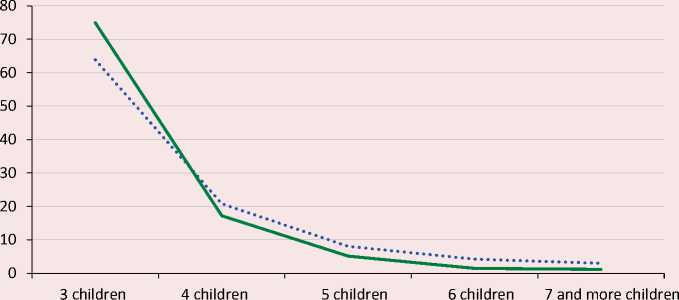
Parental family Planned number of children
Table 3. Number of children in parental families and planned number of children of students in some cities, % of the number of multi-child families
|
Makhachkala |
Maykop |
Moscow |
Pskov |
|
|
Parental family |
||||
|
3 children |
47.6 |
76.6 |
78.1 |
71.4 |
|
4 children |
36.5 |
17.0 |
15.6 |
14.3 |
|
5 children |
9.5 |
4.3 |
0.0 |
4.8 |
|
6 children |
4.8 |
0.0 |
0.0 |
9.5 |
|
7 and more children |
1.6 |
2.1 |
6.3 |
0.0 |
|
Planned number of children |
||||
|
3 children |
59.6 |
47.4 |
83.9 |
82.4 |
|
4 children |
28.8 |
33.3 |
12.9 |
17.6 |
|
5 children |
7.7 |
12.3 |
3.2 |
0.0 |
|
6 children |
3.8 |
7.0 |
0.0 |
0.0 |
|
7 and more children |
0.0 |
0.0 |
0.0 |
0.0 |
The choice of reproductive behavior model depends on the influence of various factors. One of the key ones is moral and psychological, in particular, the formation of an ideal family image from the point of view of its childhood among young people is largely due to the widespread perception of families with different numbers of children in society.
The survey of multi-child families (mothers) “Lifestyle of multi-child families in Russia” conducted by the Department of Family Sociology and Demography of the Faculty of Sociology of Lomonosov Moscow State University (The head is A.I. Antonov) in 2007–2008 showed that with the family transition to multi-child family status, the feeling of negative attitude from others increases sharply (Fig. 10) .
Figure 10. Subjective feeling of changing attitudes on the part of others at the birth of another child in the family (survey of mothers with many children), %
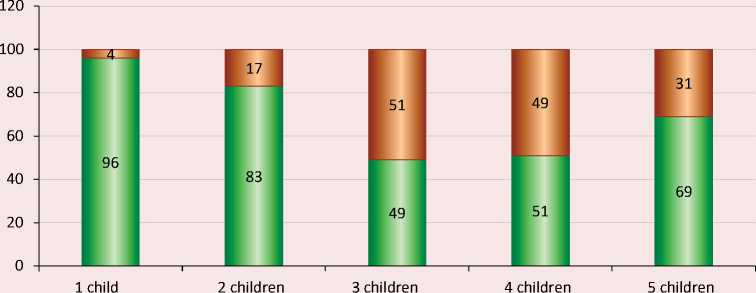
п Attitude has changed for the better □ Attitude has changed for the worse
According to: Lifestyle of multi-child families in Russia. Preliminary results of the All-Russian survey of multi-child families in 2007–2008. Natural Birth. Available at:
For instance, at the birth of the third child, 51% of the surveyed mothers with many children feel a change in the attitude of others for the worse. At the birth of the fourth child, about half of the respondents also feel the negative attitude of others. MSU researchers see the reasons for this transformation of relations in the attitudes and personal conflicts of the surrounding people themselves, as well as in parents’ behavior with many children, in particular mothers, who expect hostility from the environment and thereby attract it to themselves.
At the same time, families with five children do not experience such a sharp negative attitude. The share of respondents who feel the deterioration of attitudes from others was 31%. This change is explained by the parents’ ability with many children to get along with people and avoid negativity.
In our study, we have made an attempt find out, first, whether such a negative comes from the younger generation, and second, how the attitude toward families of relatives, friends, relatives will affect the formation of their own preferences among children. The survey results showed that if the birth of the first and second children is approved by young people, then the birth of the third and subsequent children does not meet with pronounced emotions (the attitude of about 60% of respondents “will not change in any way”; Tab. 4 ).
At the same time, with the birth of the next child, the negative assessment of parents’ reproductive behavior increases. In the families of friends, 12.9% of respondents demonstrate a negative attitude to the birth of the fifth and subsequent children. The positive attitude is sharply reduced (from 56.0% at the birth of the first child to 27.1% at the birth of the fifth and subsequent children).
Based on this, we should note a peculiar phenomenon: modern young people tend to have more children with improved living conditions. At the same time, the increase occurs against the background of an increase in negative attitudes toward the large number of people around.
Conclusion
Summing up, it is worth noting that the reproductive attitudes of modern youth toward having many children, on the one hand, represent a number of logical and expected judgments, and on the other hand, reflect contradictory opinions regarding the multi-child family model.
So, the most popular family model in the view of modern youth is a two-child family. At the same time, almost a third of respondents would like to become parents with many children. This value is significantly higher than the current indicators of the statistics of multi-child families in Russia.
With the improvement of socio-economic living conditions and the formation of psychologically comfortable environment, modern youth is ready to implement much more optimistic reproductive plans. At the same time, the ideal family model in the view of young people differs from the desired one for the “worse” from the point of view of childhood. Moreover, almost half of the respondents already want to have more than the ideal number of children in the current conditions. The probable reason for such a contradiction may be the use of different grounds in forming students’ judgments about these two issues. When answering the question about
Table 4. Changing attitudes toward families of relatives, friends, acquaintances at the birth of another child, %
|
It will change for the better |
It will change for the worse |
It will change in no way |
|
|
First |
56.0 |
0.7 |
43.3 |
|
Second |
50.5 |
1.3 |
48.2 |
|
Third |
38.7 |
3.8 |
57.5 |
|
Fourth |
28.7 |
8.6 |
62.6 |
|
Fifth and subsequent |
27.1 |
12.9 |
60.0 |
their own reproductive plans, the whole complex of reproductive choice factors is considered including respondents’ economic living conditions, parental family’s experience, families of friends and relatives, dissemination of the image of a prosperous family in the media, etc. The answers about the ideal family model may be more influenced by the assessment of the economic situation in the country and the region/city of the respondents’ residence in terms of possibility of maintaining and raising children. This situation can act as a deterrent to the birth of more children and make it difficult for the state to get out of demographic crisis.
In Russia, there is a significant differentiation of regions in terms of fertility (crude birth rate, total fertility rate, etc.), which, according to the research results, will continue in the future. Similar regional differences are observed in youth’s orientation to having many children.
Modern students tend to “copy” reproductive behavior of their parents. However, the “depth” of having many children turned out to be less in comparison with the childhood of parental families. Young people focused on having many children tend to become three-child parents rather than have more children.
Despite their relatively optimistic reproductive plans, young people demonstrate an increase in negative attitudes toward large number of children around them. This phenomenon can be considered as a possible barrier to a more complete implementation of reproductive plans, which it is advisable to level out within the framework of state family policy. Possible reasons for the negative attitude toward the surrounding multi-child families may be a special behavior model of such parents and children in society. However, it is often formed due to the unsuitability of the environment for the life of families with a large number of children. Consequently, by changing the space, logistics schemes, making them more comfortable for large families, it is possible to reduce the negative attitude of others.
In addition, the growth of negative attitudes toward multi-child families may be caused by more active support of such families from the state in comparison with one- and two-child families. In particular, the survey revealed that despite the predominance of the respondents’ approving attitude toward more active support for multi-child families, there is a statistically significant proportion of people who deny this idea and speak out for equal rights. In this regard, it is advisable, without reducing and to some extent expanding support for multi-child families, to pay more attention to the problems of other types of families, in particular with one child and two children. Of course, this is not a complete list of possible reasons for the negative attitude toward a large number of children around. This issue requires further, longer and possibly interdisciplinary study.
Thus, if the reproductive plans of modern students are fully implemented, the demographic situation in the country as a whole may improve somewhat. Trends toward having many children make it possible to maintain positive dynamics. Consequently, there are objective reasons to believe that state demographic policy programs, aimed at supporting families and increasing the birth rate, should be continued and expanded.
Список литературы Reproductive attitudes of modern youth toward multi-child parenting: patterns and contradictions
- Archangelsky V.N., Shulgin S.G., Zinkina Yu.V. (2020). Reproductive behavior of Russian women as depending on their level of education. Vestnik RUDN. Seriya: Sotsiologiya=RUDN Journal of Sociology, 20(3), 546–559. DOI: 10.22363/2313-2272-2020-20-3-546-559 (in Russian).
- Arkhangelskiy V.N., Rostovskaya T.K., Vasilieva E.V. (2021). Influence of the standard of living on the reproductive behavior of Russians: Gender aspect. Zhenshchina v rossiiskom obshchestve. Spetsial’nyi vypusk=Woman in Russian Society. Special Issue, 3–24. DOI: 10.21064/WinRS.2021.0.1 (in Russian).
- Atake EH., Gnakou Ali P. (2019). Women’s empowerment and fertility preferences in high fertility countries in Sub-Saharan Africa. BMC Women’s Health, 19, 54. Available at: https://doi.org/10.1186/s12905-019-0747-9
- Baschieri A., Cleland J., Floyd S. et al. (2013). Reproductive preferences and contraceptive use: A comparison of monogamous and polygamous couples in northern Malawi. Journal of Biosocial Science, 45(2), 145–166. Available at: https://doi.org/10.1017/S0021932012000569
- Belinskaya D.V. (2018). Social portrait of childfree. Vestnik Tambovskogo universiteta. Seriya Obshchestvennye nauki=Tambov University Review. Series: Social Sciences, 4(13), 12–19 (in Russian).
- Belova V.A. (1975). Chislo detei v sem’e [Number of Children in the Family]. Moscow: Statistika.
- Belova V.A., Darskii L.E. (1972). Statistika mnenii v izuchenii rozhdaemosti [Opinion Statistics in the Study of Fertility]. Moscow: Statistika.
- Churilova E.V., Zakharov S.V. (2019). Reproductive attitudes of the Russian population: Is there a reason for optimism? Vestnik obshchestvennogo mneniya=Bulletin of Public Opinion, 2 (129), 69–89 (in Russian).
- Dobrokhleb V.G., Zvereva N.V. (2016). The potential of modern Russian generations. Ekonomicheskie i sotsial’nye peremeny: fakty, tendentsii, prognoz=Economic and Social Changes: Facts, Trends, Forecast, 2 (44), 61–78. DOI: 10.15838/esc/2016.2.44.4 (in Russian).
- Dumnova E.M. (2009). The factors-determinants of reproductive purposes of youth (on the example of the city of Novosibirsk). Vestnik TGPU=Tomsk State Pedagogical University Bulletin, 9(87), 116–119 (in Russian).
- Garaeva E.I. (2018). The fundamental reasons and motives for voluntary childlessness in the modern society. Obshchestvo: sotsiologiya, psikhologiya, pedagogika=Society: Sociology, Psychology, Pedagogics, 9(53), 47–51. DOI: 10.24158/spp.2018.9.9 (in Russian).
- Garaeva E.I. (2020). Reproductive attitudes of megapolis youth (based on the materials of Yekaterinburg). Gumanitarnye, sotsial’no-ekonomicheskie i obshchestvennye nauki=Humanities, Social-Economic and Social Sciences, 5, 48–51 (in Russian).
- Grishina O.V. (2006). Reproductive behavior of parents and their children in Russia. Vestnik Moskovskogo Universiteta. Seriya 6. Ekonomika=Moscow University Economic Bulletin, 6, 29–41 (in Russian).
- Günther I., Harttgen K. (2016). Desired fertility and number of children born across time and space. Demography, 53, 55–83. Available at: https://doi.org/10.1007/s13524-015-0451-9
- Johnstone M., Lucke J., Hewitt B. (2021). Life transitions and women’s desired number of children: The impact of motherhood, relationships and employment. Community, Work & Family, 24(5), 616–635. DOI: 10.1080/13668803.2020.1744526
- Kalachikova O.N. (2012). Some aspects of students’ reproductive behavior. Vysshee obrazovanie v Rossii=Higher Education in Russia, 3, 132–136 (in Russian).
- Karpova V.M. (2019). Features of the intergenerational transmission of family values. Vestnik Moskovskogo Universiteta. Seriya 18. Sotsiologiya i politologiya=Moscow State University Bulletin. Series 18. Sociology and Political Sciences, 25(3), 117–139. DOI: 10.24290/1029-3736-2019-25-3-117-139 (in Russian).
- Koropeckyj-Cox T., Çopur Z., Romano V., Cody-Rydzewski S. (2018). University students’ perceptions of parents and childless or childfree couples. Journal of Family Issue, 39(1), 1–25. DOI: 10.1177/0192513X15618993
- Lotfi R., Rajabi Naeeni M., Rezaei N., Farid M., & Tizvir A. (2017). Desired numbers of children, fertility preferences and related factors among couples who referred to pre-marriage counseling in Alborz province, Iran. International journal of Fertility & Sterility, 11(3), 211–219. Available at: https://doi.org/10.22074/ijfs.2017.5010
- Molla H.L., Muluneh E.K. (2019). Factors influencing desired number of children among Ethiopian women: Application of count regression models. Research Square. Available at: https://doi.org/10.21203/rs.2.17780/v1
- Nakkerud E. (2021). Ideological dilemmas actualised by the idea of living environmentally childfree. Hu Arenas. Available at: https://doi.org/10.1007/s42087-021-00255-6
- Newport F., Wilke J. (2013). Desire for children still norm in U.S. GALLUP. Available at: https://news.gallup.com/poll/164618/desire-children-norm.aspx
- Obukhov K.N. (2021). Attitudes towards family and reproduction among young people in the Udmurt Republic (based on the data from “youth of Udmurtia – 2019” monitoring project). Vestnik Udmurtskogo universiteta=Bulletin of Udmurt University. Sociology. Political Science. International Relations, 5(3), 311–321 (in Russian).
- Popova L.A., Shishkina M.A. (2016). Marriage and family and reproductive attitudes of today’s young people. Problemy razvitiya territorii=Problems of Territory’s Development, 5(85), 57–71 (in Russian).
- Rodin K. (2020). Demograficheskaya politika Rossiiskoi Federatsii: faktory stimulirovaniya prinyatiya resheniya o rozhdenii pervogo i vtorogo rebenka, a takzhe posleduyushchikh detei: doklad [Demographic Policy of the Russian Federation: Factors Stimulating Decision-Making on the Birth of the First and Second Children, as well as Subsequent Children: Report]. Available at: https://wciom.ru/fileadmin/file/reports_conferences/2020/2020-11-02_Demografija.pdf (accessed: October 30, 2021).
- Sigareva E., Sivoplyasova S. (2021). Reproductive and migration attitudes of contemporary youth of EAEU states (Russia, Kazakhstan, Kyrgyzstan: A case study). Central Asia and the Caucasus, 22(2), 122–139. Available at: https://doi.org/10.37178/ca-c.21.2.11
- Sivoplyasova S.Yu., Sigareva E.P. (2018). Having many children in Russia: Status and prospects. Sotsial’nye tekhnologii, issledovaniya=Social Technologies, Studies, 2, 83–95 (in Russian).
- Volchenkova E.V. (2014). Peculiarities in reproduction attitudes of modern youth. Vestnik Vyatskogo gosudarstvennogo gumanitarnogo universiteta=Herald of Vyatka State University, 8, 21–25 (in Russian).
- Yashuk A.G., Maslennikov A.V., Rakhmatullina I.R., Ishmuratov N.A. (2019). Study of reproductive behavior model of undergraduates of Ufa universities. Meditsinskii vestnik Bashkortostana=Bashkortostan Medical Journal, 14, 3(81), 38–40 (in Russian).
- Yaya O.S., Osanyintupin O.D. (2018). Determinants of desired and actual number of children and the risk of having more than two children in Ghana and Nigeria. MPRA Paper, 88824. Available at: https://mpra.ub.uni-muenchen.de/88824/
- Zubok Yu.A. (2020). Youth: Life strategies in a new reality. Monitoring obshchestvennogo mneniya: ekonomicheskie i sotsial’nye peremeny=Monitoring of Public Opinion: Economic and Social Changes, 3, 4–12. DOI: 10.14515/monitoring.2020.3.1688 (in Russian)
- Zubok Yu.A., Chuprov V.I. (2020). Youth’s activity in changing reality: Self-regulation contradictions. Ekonomicheskie i sotsial’nye peremeny: fakty, tendentsii, prognoz=Economic and Social Changes: Facts, Trends, Forecast, 13(6), 215–231. DOI: 10.15838/esc.2020.6.72.13 (in Russian).

